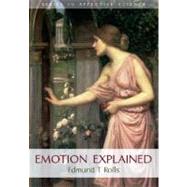
Note: Supplemental materials are not guaranteed with Rental or Used book purchases.
Purchase Benefits
Looking to rent a book? Rent Emotion Explained [ISBN: 9780198570042] for the semester, quarter, and short term or search our site for other textbooks by Rolls, Edmund T.. Renting a textbook can save you up to 90% from the cost of buying.
| Introduction: the issues | |
| Introduction | |
| Rewards and punishers | |
| Approaches to emotion and motivation | |
| Outline | |
| The nature of emotion | |
| Introduction | |
| A theory of emotion | |
| Different emotions | |
| Refinements of the theory of emotion | |
| The classification of emotion | |
| Other theories of emotion | |
| Individual differences in emotion, personality and emotional intelligence | |
| Cognition and emotion | |
| Emotion, motivation, reward and mood | |
| The concept of emotion | |
| Advantages of the approach | |
| The functions of emotion: reward, punishment and emotion in brain design | |
| Introduction | |
| Brain design and the functions of emotion | |
| Selection of behaviour: cost-benefit 'analysis' | |
| Further functions of emotion | |
| The functions of emotion in an evolutionary, Darwinian, context | |
| The functions of motivation in an evolutionary, Darwinian, context | |
| Are all goals for action gene-specified? | |
| The brain mechanisms underlying emotion | |
| Introduction | |
| Overview | |
| Representations of primary reinforcers | |
| Representing potential secondary reinforcers | |
| The orbitofrontal cortex | |
| The amygdala | |
| The cingulate cortex | |
| Human brain imaging investigations of mood and depression | |
| Output pathways for emotional responses | |
| Effects of emotion on cognitive processing and memory | |
| Laterality effects in human emotional processing | |
| Summary | |
| Hunger | |
| Introduction | |
| Peripheral signals for hunger and satiety | |
| The control signals for hunger and satiety | |
| The brain control of eating and reward | |
| Obesity, bulimia and anorexia | |
| Conclusions on reward, affective responses to food, and the control ofappetite | |
| Thirst | |
| Introduction | |
| Cellular stimuli for drinking | |
| Extracellular thirst stimuli | |
| Control of normal drinking | |
| Reward and satiety signals for drinking | |
| Summary | |
| Brain-stimulation reward | |
| Introduction | |
| The nature of the reward produced | |
| The location of brain-stimulation reward sites in the brain | |
| The effects of brain lesions on intracranial self-stimulation | |
| The neurophysiology of reward | |
| Some of the properties of brain-stimulation reward | |
| Stimulus-bound motivational behaviour | |
| Conclusions | |
| Apostasis | |
| Pharmacology of emotion, reward and addiction; the basal ganglia | |
| Introduction | |
| The noradrenergic hypothesis | |
| Dopamine and reward | |
| The basal ganglia | |
| Opiate reward systems, analgesia, and food reward | |
| Pharmacology of depression in relation to brain systems involved in emotion | |
| Pharmacology of anxiety in relation to brain systems involved in emotion | |
| Cannabinoids | |
| Overview of behavioural selection and output systems involved in emotion | |
| Sexual behaviour, reward and brain function; sexual selection of behaviour | |
| Introduction | |
| Mate selection, attractiveness and love | |
| Parental attachment, care and parent-offspring conflict | |
| Sperm competition | |
| Concealed ovulation and its consequences for sexual behaviour | |
| Sexual selection of sexual and non-sexual behaviour | |
| Individual differences in sexual rewards | |
| The neural reward mechanisms that might mediate some aspects of sexualbehaviour | |
| Neural basis of sexual behaviour | |
| Conclusion | |
| Emotional feelings and consciousness: a theory of consciousness | |
| Introduction | |
| A theory of consciousness | |
| Dual routes to action | |
| Representations | |
| Discussion | |
| Conclusions and comparisons | |
| Conclusions and broader issues | |
| Conclusions | |
| Decision-making | |
| Emotion and ethics | |
| Emotion and literature | |
| Close | |
| Neural networks and emotion-related learning | |
| Reward reversal in the orbitofrontal cortex - a model | |
| Table of Contents provided by Publisher. All Rights Reserved. |
The New copy of this book will include any supplemental materials advertised. Please check the title of the book to determine if it should include any access cards, study guides, lab manuals, CDs, etc.
The Used, Rental and eBook copies of this book are not guaranteed to include any supplemental materials. Typically, only the book itself is included. This is true even if the title states it includes any access cards, study guides, lab manuals, CDs, etc.